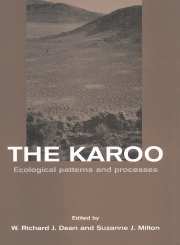Book contents
- Frontmatter
- Contents
- List of contributors
- Foreword
- Preface
- Acknowledgements
- Part one Biogeographic patterns and the driving variables
- 1 The climate of the karoo – a functional approach
- 2 Soils of the arid south-western zone of Africa
- 3 Palaeoenvironments
- 4 Plant biogeography, endemism and diversity
- 5 Biogeography, endemism and diversity of animals in the karoo
- Part two Form and function
- Part three Dynamics
- Part four Human impacts
- Part five Comparisons
- References
- Index
5 - Biogeography, endemism and diversity of animals in the karoo
Published online by Cambridge University Press: 23 December 2009
- Frontmatter
- Contents
- List of contributors
- Foreword
- Preface
- Acknowledgements
- Part one Biogeographic patterns and the driving variables
- 1 The climate of the karoo – a functional approach
- 2 Soils of the arid south-western zone of Africa
- 3 Palaeoenvironments
- 4 Plant biogeography, endemism and diversity
- 5 Biogeography, endemism and diversity of animals in the karoo
- Part two Form and function
- Part three Dynamics
- Part four Human impacts
- Part five Comparisons
- References
- Index
Summary
Introduction
The south-western arid zone of Africa, which includes the Namib and Kalahari Deserts, and the succulent and Namakaroo biomes, is rich in plant and animal species, and in endemism. The distribution of many animals, however, in this region is poorly known, and is further complicated by the presence of many undescribed species, particularly among the invertebrates.
In this chapter, a species is defined as a discrete entity which remains in equilibrium during phases of environmental stability. It is assumed that there is only one type of species. A species is a set of populations of individuals spatio-temporally bounded by birth, death and finite geographical boundaries. The individuals of a species have phenotypic resemblance and shared reproductive systems. They are capable of recognizing and responding to each other, breeding together and producing fertile offspring. There are no adaptations which are the property of a species and not of individuals, and it is the individuals which are the units of natural selection. The attributes ascribed to species such as habits, niche, breeding system, are in fact the properties of the individuals. A relict species is one which clearly is isolated from conspecifics, and here considered to be a faunal remnant from a prior, different epoch. An isolated species is one with a restricted distribution which is disjunct from congeners.
Biogeography takes cognizance of evolutionary and speciation events and aims to explain the distribution patterns of all organisms. An endemic species or higher taxon is one whose distribution is geographically limited, but this endemicity provides no information about the place where that organism evolved.
- Type
- Chapter
- Information
- The KarooEcological Patterns and Processes, pp. 57 - 86Publisher: Cambridge University PressPrint publication year: 1999
- 15
- Cited by



